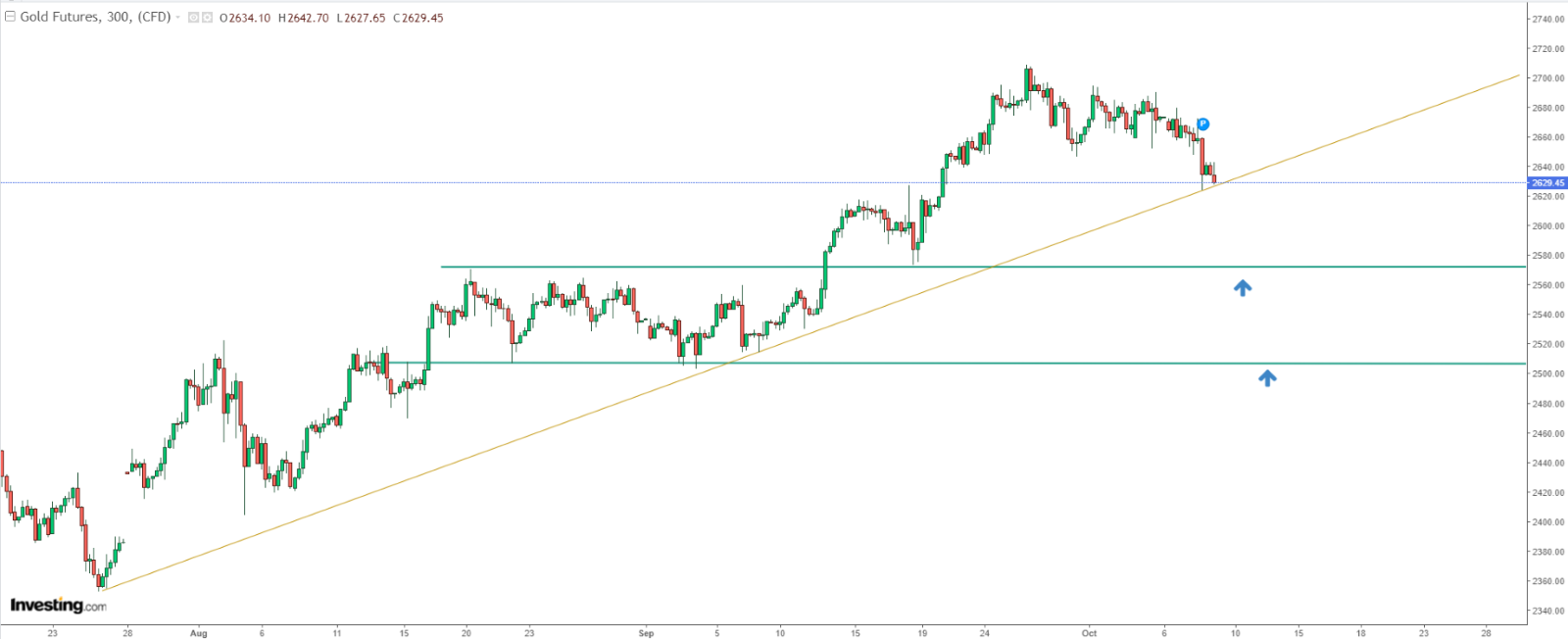- Gold has had a poor start to the month, down just below 2%.
- However, inflows into Gold ETFs have maintained an upward trend.
- Could this correction spark a dip-buying opportunity?
- Are you looking for actionable trade ideas to navigate the current market volatility? Unlock access to InvestingPro’s AI-selected stock winners for under $9 a month!
Gold’s remarkable surge in late September, pushing just shy of $2,700 per ounce, has hit a speed bump as October kicked off with a correction phase.
Strong U.S. labor market data has tempered expectations of aggressive Fed rate cuts, limiting the likelihood of a larger-than-expected cut.
With a strengthening U.S. dollar and cooling sentiment on monetary easing, gold faces short-term pressure.
However, this dip could present an opportunity for long-term investors to join the uptrend at a more favorable entry point.
Dollar Strength and Bond Yields Weigh on Gold, but Bulls Aren’t Out
As the month begins, gold is experiencing its first significant pullback since July’s rally, driven by the U.S. dollar’s resurgence and rising bond yields.
These factors have traditionally acted as headwinds for gold, making the yellow metal less attractive in comparison.
The Fed’s anticipated rate cut has been dialed back to 25 basis points, further fueling short-term bearish sentiment. Technically, gold prices may dip below $2,600 per ounce in the near term, creating potential buying opportunities.
While geopolitical tensions in the Middle East would typically bolster gold prices, investor focus has shifted towards the dollar as the preferred safe haven.
Following several months of underperformance, the greenback is now seen as more attractive, especially against gold, which continues to trend upwards.
Over the longer term, however, gold demand is expected to rise as the Fed gradually loosens monetary policy in the coming quarters, regardless of the pace.
September Gold ETF (NYSE:GLD) Inflows Highlight Continued Demand
Despite recent corrections, demand for gold remains resilient. September marked the fifth consecutive month of inflows into gold-backed ETFs, with 18.4 metric tons added, representing $1.4 billion in nominal terms.
Total assets under management in these funds now stand at $270.9 billion, with North American-listed ETFs holding the largest share.
October’s data will be critical in assessing whether this demand will persist or if lower prices will tip the balance in favor of sellers.
Will Gold Dip Below $2,600?
As mentioned earlier, gold is currently testing key support levels, with prices hovering near $2,570 per ounce.
The base case scenario suggests a continued decline towards $2,500, but this appears to be more of a short-term correction rather than the start of a broader downtrend.
Much will depend on how buyers react to these lower levels. Should demand pick up, gold may quickly rebound, solidifying its long-term bullish trajectory.

In summary, while gold is facing some short-term challenges, the broader picture remains positive.
Investors should keep an eye on key technical levels and upcoming macroeconomic data, as these could offer valuable entry points for those looking to capitalize on gold’s long-term strength.
***
Disclaimer: This article is written for informational purposes only. It is not intended to encourage the purchase of assets in any way, nor does it constitute a solicitation, offer, recommendation or suggestion to invest. I would like to remind you that all assets are evaluated from multiple perspectives and are highly risky, so any investment decision and the associated risk is at the investor's own risk. We also do not provide any investment advisory services.
